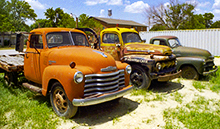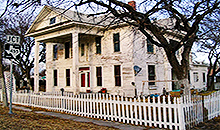Main Menu
Denton County Data
Denton County Communities & Places
Genealogy & History Links by USGHN
Important Denton County Addresses
Sponsors
Denton County Neighbors
Collin County, Texas
Cooke County, Texas
Dallas County, Texas
Grayson County, Texas
Tarrant County, Texas
Wise County, Texas
Other Websites
Welcome to Denton County Texas Genealogy & History Network!
Welcome to the Denton County, Texas Genealogy & History Network. Our purpose is to provide visitors with free resources for genealogical and historical research. To share your genealogy or history information, send an email to txghn@outlook.com and we will happily include it here. For other Texas Counties, visit the Texas Genealogy & History Network state website and go to the appropriate county. Thanks for visiting and good luck with your research! |
|
About Denton County, Texas...

Denton County is located in north central Texas. The Elm Fork of the Trinity River flows through the east central part of the county. It was dammed in the 1920s to form Lake Dallas, which has since been joined with Garza–Little Elm Reservoir to form Lewisville Lake. In the Cross Timbers and the floodplains of the creeks black jack and post oak, pecan, white ash, sycamore, cottonwood, hackberry, elm, and willow trees predominate. Most of the rest of the county was originally covered by grasses.
White settlement began after William S. Peters, of Louisville, Kentucky, and several others, obtained a land grant from the Texas Congress in 1841. The land settled by their company, the Texian Land and Immigration Company, became known as the Peters colony. Their grant included all of the future Denton County, as well as parts or all of several other future counties. The earliest settlement in what became Denton County was in the southeastern section, near the site of present Hebron, and most of the early residents took up land in the Cross Timbers.
Although a few came from the lower South, most antebellum settlers in the area came from the upper South. In 1850, 40 percent gave Tennessee and Kentucky as their state of birth. Immigration from the upper South predominated because of the Kentucky-based Peters Company. The county was also limited to subsistence agriculture due to a lack of water transportation.
 In the 1840s Denton County was the site of the Icarian colony, a French utopian settlement north of the site of present Justin. The Icarians gave up and left after a few months of sickness and disappointment and made virtually no lasting mark on the county. The same cannot be said of the German community of Blue Mound. Descendants of many of the German families that began settling there in the 1870s were still among the residents of the community a century later.
In the 1840s Denton County was the site of the Icarian colony, a French utopian settlement north of the site of present Justin. The Icarians gave up and left after a few months of sickness and disappointment and made virtually no lasting mark on the county. The same cannot be said of the German community of Blue Mound. Descendants of many of the German families that began settling there in the 1870s were still among the residents of the community a century later.
In 1846, the Texas legislature formed Denton County out of what had been a much larger Fannin County. A county seat, named Pinckneyville, was located near the center of the county, at a spot about a mile southeast of the present center of Denton. Although county officials were elected in 1846, no courthouse was built, and less than two years later a site named Alton, three or four miles to the southeast, was made county seat. A log courthouse, the first in the county, was built there.
Alton soon had stores, residences, and a hotel and was a regular stage stop. In the summer of 1856, however, county residents voted to establish a new county seat near the center of the county. The new town, named Denton, was established the next year, but was not incorporated as a city until 1866.
 Denton County grew slowly until after the Civil War. Almost all residents were still engaged in subsistence agriculture. Cotton ginned that year totaled only two bales. Growth was rapid, however, in the decade of the 1870s. Many new residents began farms, and in 1880 almost 50 percent of the county was in cultivation.
Denton County grew slowly until after the Civil War. Almost all residents were still engaged in subsistence agriculture. Cotton ginned that year totaled only two bales. Growth was rapid, however, in the decade of the 1870s. Many new residents began farms, and in 1880 almost 50 percent of the county was in cultivation.
The county's population growth and its economic and cultural life were much influenced by the location in Denton of two large state-supported universities. The University of North Texas, as well as Texas Woman's University, which originated in 1903 as Girls' Industrial College.
The location of Dallas–Fort Worth International Airport played a large part in the growth of Denton County after 1940. During World War II the county began to serve noticeably as a bedroom area for Dallas–Fort Worth. All of the towns and cities of the county had a significant commuter element, but the southeastern portion, growing most rapidly, was virtually an extension of Dallas–Fort Worth. Lewisville, The Colony, and the part of Carrollton in Denton County were all population centers because they were suburbs of Dallas.
 Many new rural residents owned small spreads, and mobile homes vied with expensive, sprawling ranch houses for space. Large horse ranches were scattered through the county; in 1983 horses brought in $17,207,400, a significantly larger income than that from any other agricultural product. Newcomers and many older residents returned much of Denton County's rich cropland to pasture, and by the 1980s rural areas, almost depopulated by the rural-to-urban shift after World War II, had probably returned to their 1920s level in density of population.
Many new rural residents owned small spreads, and mobile homes vied with expensive, sprawling ranch houses for space. Large horse ranches were scattered through the county; in 1983 horses brought in $17,207,400, a significantly larger income than that from any other agricultural product. Newcomers and many older residents returned much of Denton County's rich cropland to pasture, and by the 1980s rural areas, almost depopulated by the rural-to-urban shift after World War II, had probably returned to their 1920s level in density of population.
Denton County attractions included Lewisville and Grapevine lakes, the annual Jazz Fest held in September, and the North Texas State Fair in August.
The county has a total area of 953 square miles, of which 878 square miles is land and 75 square miles (7.8%) is water. The population recorded in the 1850 Federal Census was 641. The 2010 census recorded 662,614 residents there.
Neighboring counties are Cooke County (north), Grayson County (northeast), Collin County (east), Dallas County (southeast), Tarrant County (south), and Wise County (west).
 The county seat is Denton. Other communities in the county include Argyle, Aubrey, Bartonville, Bolivar, Carrollton (part), Coppell (part), Copper Canyon, Corinth, Corral City, Cross Roads, Dallas (part), DISH, Double Oak, Elizabethtown, Flower Mound, Fort Worth (part), Frisco (part), Hackberry, Haslet (part), Hebron, Hickory Creek, Highland Village, Justin, Krugerville, Krum, Lake Dallas, Lakewood Village, Lewisville, Lincoln Park, Little Elm, Northlake, Oak Point, Pilot Point, Plano (part), Ponder, Prosper (part), Providence Village, Roanoke, Sanger, Shady Shores, Southlake (part), The Colony, Trophy Club, and Westlake (part).
The county seat is Denton. Other communities in the county include Argyle, Aubrey, Bartonville, Bolivar, Carrollton (part), Coppell (part), Copper Canyon, Corinth, Corral City, Cross Roads, Dallas (part), DISH, Double Oak, Elizabethtown, Flower Mound, Fort Worth (part), Frisco (part), Hackberry, Haslet (part), Hebron, Hickory Creek, Highland Village, Justin, Krugerville, Krum, Lake Dallas, Lakewood Village, Lewisville, Lincoln Park, Little Elm, Northlake, Oak Point, Pilot Point, Plano (part), Ponder, Prosper (part), Providence Village, Roanoke, Sanger, Shady Shores, Southlake (part), The Colony, Trophy Club, and Westlake (part).
Denton County, Texas Records
Birth Records - The Texas Department of State Health Services has records from 1903 to present. Records for the last 75 years considered private and will only be provided to certain individuals. To obtain current information on who may obtain a record, how to submit a request and an official request form, see the Texas Department of State Health Services website or write to Texas Vital Records, Department of State Health Services, P.O. Box 12040, Austin, TX 78711-2040.
For older birth records you will have to write to the County Clerk of the applicable county. The existence of birth records prior to 1903 will vary widely from county to county. Local historical societies and genealogy collections in local libraries may be able to provide some information.
Death Records - The Texas Department of State Health Services has records from 1903 to present. Records for the last 25 years considered private and will only be provided to certain individuals. To obtain current information on who may obtain a record, how to submit a request and an official request form, see the Texas Department of State Health Services website or write to Texas Vital Records, Department of State Health Services, P.O. Box 12040, Austin, TX 78711-2040.
Marriage Records - The Texas Department of State Health Services can provide a verification letter of marriage for Texas marriages from 1966 to present. This is NOT a marriage license. To obtain a certified copy of a marriage license you must contact the County or District Clerk in the county or district where the marriage took place.
Local historical societies and genealogy collections in local libraries may be able to provide some information.
Divorce Records - The Texas Department of State Health Services can provide a verification letter of divorce for Texas divorces from 1968 to present. This is NOT a copy of the divorce decree. To obtain a certified copy of a copy of the divorce decree you must contact the County or District Clerk in the county or district where the divorce took place.
Local historical societies and genealogy collections in local libraries may be able to provide some information.




